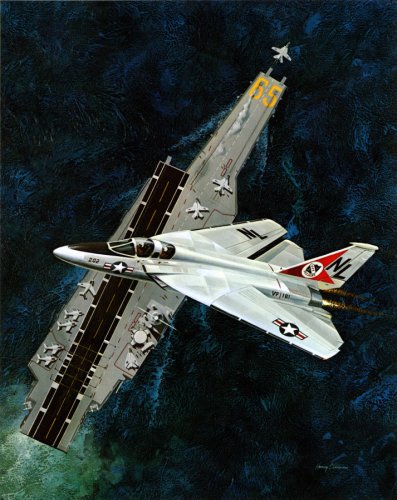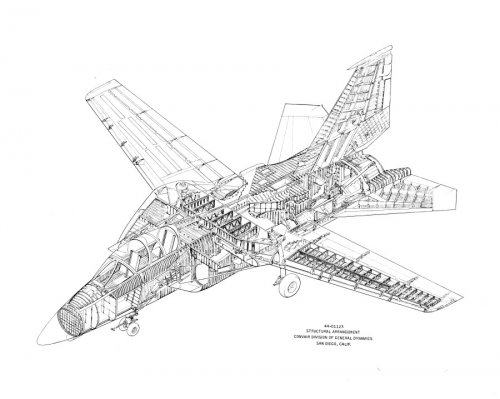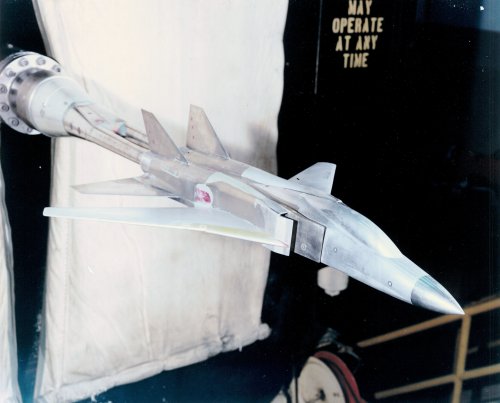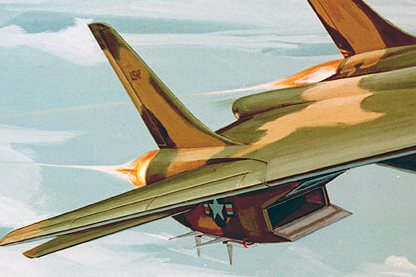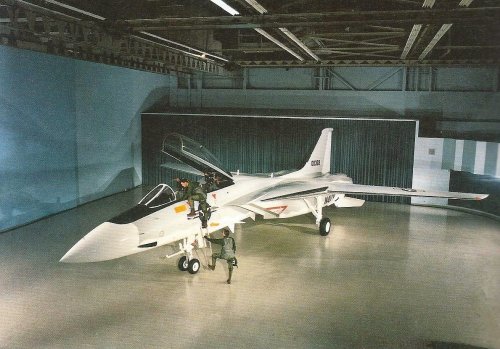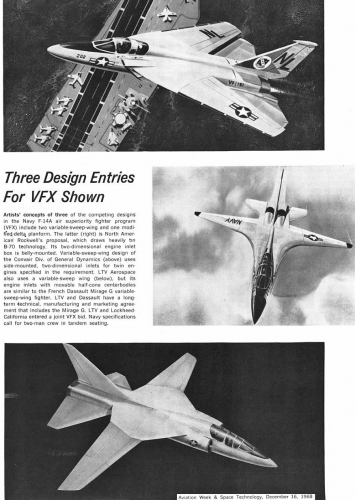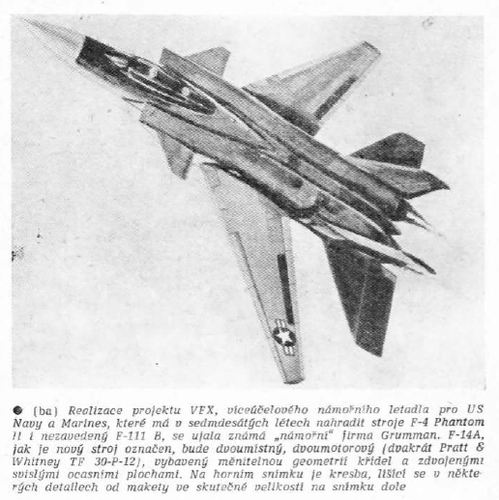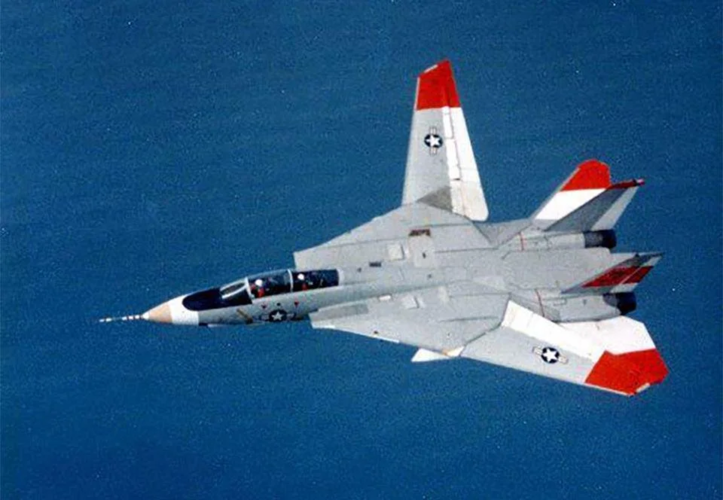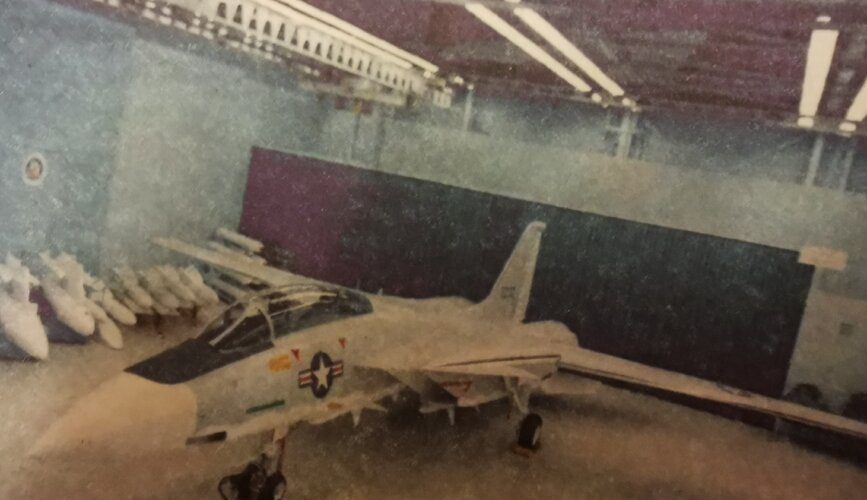From Congressional Record Volume V117 Part 26 comes a list of VFX related reports:
SAMPLING OF F-14/PHOENIX APPLICABLE STUDIES
“Navy Fighter Study” Vol I 28 March 1968–Analysis of costs, performance, and Schedules of alternative aircraft and their capabilities in Fleet Air Defense and other fighter roles.
“Navy Fighter Study" Vol II Threat Analysis 28 March 1968–Analysis of anticipated threats and likely tactical situations for U.S. Naval Forces during the mid 1970's.
Chief of Naval Operations Secret Report “The Navy Fighter Program” May 1968– This report presents the entire rationale for the VFX (now the F-14) fighter program. It includes threat assessment, consideration of alternatives, force level and cost effectiveness implications, etc.
Chief of Naval Operations Secret Report “Navy Fighter Study—Phase II” 20 May 1968.-This study reexamined the operational effectiveness contributions of the AWG-9/ Phoenix and the AWG-10/Sparrow systems and again concluded that the AWG-9/ Phoenix capabilities are essential to meet the broad spectrum of threats.
Research Management Corporation Report No. S-02094 of 20 March 1968.-Independent cost estimates for the F-14 based on Statistical analysis of the cost of high performance aircraft produced over the past several years.
Development Concept Paper for VFAX of 23 Jan. 1968.-Analysis of the pros and cons for developing a multi-mission VF and VA aircraft for the mid 1970's.
“VFX weapons system Proposal (U)” The Vought Aeronautics Division of the LTV Aerospace Corporation Ser 2–71200/8L–193 of 30 Sep. 1968–In 28 Volumes. An exhaustive and complete technical proposal for the VFX aircraft containing design philosophy, man agement methods, risk analysis, cost effec tiveness studies, service suitability, and com: prehensive reports of studies, wind tunnel tests, laboratory experiment, and construc tion methods. The proposal included Studies of advanced version and effectiveness.
“Model 225 Proposal for Engineering Development and Production (U)” Ser 747–07 2095 of 1 Oct 1968. The McDonnell Aircraft Company.—In 33 volumes with material as described for the LTV proposal for the VFX.
“Proposal for VFX High Performance, Carrier Based Fighter Aircraft Weapon System, Contract NO0019–69–C–0047 (U)”. The Convair Division of the General Dynamics Corporation, Report No. GDC-ACV-68–001 of 30 Sept 1968–In 23 Volumes with material as described for the LTV proposal.
“Proposal for High Performance Carrier Based Fighter Aircraft Weapon System VFX (U) ". The North American Rockwell Corporation Serial ADO-68–32 dtd 28 Sept 1968 In 32 volumes with material as described for the LTV proposal.
“Contract Definition Report and Engineering Development Proposal for the VFX weapon System (U)”. Grumman Aircraft Engineering Corporation, Serial FSR-303 dated 1 Oct 1968.-In 37 Volumes with mate rial included as described for the LTV proposal.
“The Air Target”, Vol I of Rationales for Exploratory Development Goals. (U) By the Exploratory Development Division of the Naval Material Command Headquarters dated 11 June 1968. (Secret).-Development goals for air target threat counter in the 1980 time period are exhaustively analyzed to derive parameters and values.
“Potential Effects of Defensive Electronic Countermeasures in Fleet Anti-Air Warfare (U)” by AM salyberg. Center for Naval Analyses NAvWAG Research Contribution No. 79 dated February 1968. (Secret).-The report discusses the use of missile in an ECM environment.
“Advanced Navy Multi-mission aircraft vulnerability study (U)”. The McDonnell Aircraft Company Report G095 dated 1 June 1968 (Secret).-The study analyzes aircraft design considerations, including cost trade offs, for reducing vulnerability to combat damage.
"Passive Ranging in the PHOENIX Missile system (U)" Final Report in AirTask A05– 510–C49/202–1/A10700–00 dated 19 Sept 1968 (Secret).-The report concerns the analysis of passive ranging techniques used by the Phoenix in an ECM environment.
“Phoenix Performance Data Report (U),” January 1968 (Confidential).-This report presents the current estimates of the trajectory and miss distance performance of the AIM-54A missile, and describes in detail the basis for these estimates. The missile con figuration and its parameters are described, and studies performed since December 1963 that led to this configuration are presented.
“Air Attack Threats for the Evaluation of the F-111B/Phoenix Weapon System - 1970 - 1976 Time Period (U),” NADC–AW–6617, 22 December 1967 (Secret).-This report pre sents detailed estimates of a spectrum of po tential enemy threats to task force and beachhead operations and enemy airborne defenses against friendly strike missions. The report is intended to be used as a source of information on hostile capabilities in the 1970–1976 time period for use in air warfare simulations of the F-111B/Phoenix Weapon.
“Fighter System Studies Operation Analysis” Grumman Aircraft PDR-OP–174 June 1967.-Generalized aircraft designs used in conjunction with analytical evaluations to define pertinent design areas for development of point designs, which are then evaluated through the analytical and simulation methodologies.
“VFAX Increased Fighter Performance Boeing Report” PD 7026–3 of 17 January 1967. Evaluation of threat, operational usage of VFAX, aircraft design characteristics, and performance capabilities.
“VFAX Summary Description of Aircraft Design and Engine Recommendations” Vought Aeronautics Division Report No. 2– 55400/7R–2473 of 15 December 1967.-A six volume report containing the design philosophy and substantiating data for an airframe and engine combination fulfilling the requirements of TDP 11–06R1 for VFAX aircraft.
“VFAX Aircraft Design Study" McDonnell Douglas Report C–125395 of 15 December 1967.-Performance considerations and de sign criteria leading to the selection of a VFAX engine to meet the requirements of TDP 11–06R1.
“FAX-1 Study" North American Aviation TPA-049, Task 1 (NA-67–685) dated 8 Sep tember 1967 (Secret).-An evaluation of the potential cost effectiveness of various air craft systems in the performance of tactical fighter and fighter/bomber missions. (Four volumes).
March–May 1967, NAVAIRSYSCOM “Fighter Comparison, F-4J, F-4 (VS) VFAX, F-111B.”—A comprehensive technical, cost and delivery comparison of several alternative fighter aircraft programs conducted in house and presented within the Navy.
12 October 1967, Grumman Technical Presentation, “A Cost Effective Approach to meeting the 1970–1980 Fighter Force Level Requirements.”—Grumman’s analysis and proposed solution to the fighter problem.
Advanced Fighter Aircraft Design Studies” by four (4) major airplane producers. December 1967–
(a) Grumman Model 303 submitted by letter dated 28 December 1967.
(b) Vought Aeronautics Division (LTV) Model 505 by letter dated 28 December 1967. This was followed by a letter submittal dated 26 April 1968.
(c) North American Rockwell Model 323 by letter dated 29 December 1967.
(d) McDonnell Douglas Model 225A in formally presented on 19 December 1967 and submitted on 31 December 1967.
Foregoing studies verified the Navy's in house fighter studies and provided the back up technical and cost data for the Navy Fighter Study of early 1968.
“VFAX Technical Development Plan (TDP).” dated 31 May 1967–An updating of the total development plan originally issued in 1966.
“NASA Presentation to Defense Science Board on Advanced Fighter-Attack Aircraft, LWP–447” dated 11 July 1967.-Study of FX and VFAX aircraft requirements with state of the art.
“Lockheed and Vought Aeronautics Presentation to Defense Science Board, Tactical Aircraft Task Force Meeting" 11 August 1967.-Study of FX and VFAX aircraft requirements.
“The 1975–1980 Fighter/Attack Aircraft Advanced Planning Study, Final Report (U)”, (Six Volumes) by the McDonnell Aircraft Corporation. Report B151, Vols. I to II dated 11 March 1966 (Secret).-The study develops the threat, appraises the technology, co pares the effectiveness of concepts and recommends development toward optimized systems.
Tactical Aviation Study—Progress Report Phase I 12 May 1966.-Develop an analytical rationale for the composition of future carrier air wings, for the ratio of carrier air wings to carrier decks, and for total carrier force level.
“Air Attack Threats for the Evaluation of Weapon Systems in an Anti-Air Warfare Simulation (AAWS), 1968 to 1975 Time Period (U),” NADC AWRD TM-2–66, 18 January 1966 (Secret).-The purpose of this memorandum is to define selected enemy threats in sufficient detail to permit their use in comparing weapon system effectiveness in an anti-warfare simulation. Three battle situations are provided: a fleet anti-air mission; a beachhead air superiority mission; and a strike-escort mission.
A VFAX Parametric Aircraft Design Study Report ASR-415-3 of 11 November 1966. Tradeoffs between engine size, wing area, takeoff gross weight, and costs for VFAX type aircraft.
The Fighter Gap—Naval War College by Capt. F. T. Rooney May 1966.-Evaluation of the nature of fighter aircraft, the mission, and operational criteria with resultant aircraft design requirements.
Boeing Preliminary design and Trade Study, High Performance Multi-Mission Fighter/Attack aircraft. Acceleration Trade Study. Contract NOw 65–0491–C dated April 1966.-One of the contract studies conducted to determine the sensitivity of requirements prior to a competition for a new fighter covered effect of performance requirements on size, cost, and effectiveness; compared several design approaches with foreign threat designs.
1966 FAX Study Review Team.—DDR&E sponsored group investigating Air Force and Navy fighter requirements for the FX and VFAX, respectively.
Memo CRV-18/551, 30 September 1966, (un classified).-This memo consolidates the explanation of the statistical technique used for determining the expected kill for a sequency of interceptors each carrying a mixed missile load against a wave raid.
“Warhead Lethality Comparison (U),” COMNAVMISCEN letter to COMNAVAIR DEVCEN, serial no. 00133 of 4 August 1966 (Secret).-This letter presents the results of a lethality analysis of the AIM-54A mis sile against three selected threat targets us ing specified initial conditions and fuze/war head parameters. (4 pages)
“Warhead Lethality Comparison (U),” COMNAVMISCEN letter to COMNAVAIR DEVCEN, serial no. 00183 of 21 October 1966 (Secret).-This letter compares lethality estimates for the AIM-7F, AIM-9D, and AIM-54A missiles. It also revises some data presented in reference 2 above. (5 pages)
Hughes Conf. Report B1940 “Phoenix/ VFAX study" 28 Sept 1966. -This study was performed after the need to replace the F 111B became increasingly evident. The study demonstrated the feasibility of reconfiguring the AWG-9/Phoenix system to make it compatible with a tandem, smaller, high performance fighter of the VFAX class.
Grumman Conf. Report ASR—415–2 “VFAX/AWG-9 Integration Study” dated 13 October 1966- Study performed under Contract NOw86–0567–C, investigated the feasibility of integrating a reconfigured version of the AWG-9 weapon control system and the Phoenix Missile into the VFAX class of fighter aircraft.
Anti-Air Warfare Study Contracts.
(a) McDonnell Aircraft, NOW65–0667—f dated 13 Aug 1965.
(b) Grumman Aircraft, NOwó5–0613–f dated 18 June 1965.
Contracts covered the analysis and preliminary design of fighter aircraft to replace the F–4 and F-111B airplanes. The McDonnell study covered an improved version of the F–4 while Grumman investigated major redesigns of the F-111B, new airplanes, and A–6 modifications.
Buweps Secret Report No. R–5–65–5 “Cost Effectiveness Comparison of F-111B with Selected Alternatives (U)” dated March 1965.-This study concluded that contingent upon the F-111B being a good carrier based aircraft, it was a cost effective system but dominated by the superior characteristics of the AWG-9/Phoenix system.
NASA Evaluation of F-14, 7 Aug 1969. Independent evaluation of the F-14 performance substantiated by extensive wind tunnel tests and analytical evaluations. Report verified NAVAIR evaluation of F-14 capabilities.
VFX Development Concept Paper, June 1969.-Reviews the threat, methods of countering the threat, alternatives, cost effective ness, and OSD decision to proceed with the VFX concept.
Buweps Secret Report No. R–5–65–1, Jan. 1965 “An Evaluation of Attack and Attack Fighter Aircraft for the 1970's (U)”.—A comprehensive systems analysis of a wide variety of alternative systems and force mixes. This study provided the basis for the SOR (Specific Operational Requirement) for the VFAX program which later evolved into the VFX program.
Buweps Confidential Report No. R–5–61– 14/2 “Factors Determining the TFX (N) weapon System Characteristics” dated Sep tember 1962.-An early weapon system trade off study that led to defining the AWG-9/ Phoenix weapon system characteristics and clearly demonstrated the need for a long range, multi-shot missile system for fleet air defense.
Project Stone Final Report Hughes Report PMS 86–1/2141 21 February 1969.-Comprehensive analysis of Phoenix capability against Cruise missiles and their launchers.
Phoenix Performance against Multiple Barrage Jammers Hughes Report 2143.20/17 21 February 1967.-Study results with three encounters with multiple jammers.
Comparison of Multi Mission Aircraft in a Seven Day Limited War Compaigns Analysis (U) Final Report Secret NADC–WR 6528 Naval Air Development Center, Johnsville, Pa. 30 Dec. 1965.-A computerized escort-self escort comparison of the proposed VFAX aircraft and existing aircraft. Mix ratios were examined for combinations of attack and multi-mission aircraft. The VFAX/A1B combination carrier loading was superior to the F4J/A7B and unescorted A7B.
“One versus two-can crew study final report (U)” North American Autonetics Report C6–94/312Q DCN 66AN 51181. Dated 31 Jan. 1966 (Secret).-This study, performed under Bureau of Naval Weapons contract, in vestigate crew size requirements for a 1970– 1975 time span multi-mission (air-to-air/ air-to-ground) type aircraft.
“Evaluation of Expected Kill of Mixed Loadings Against A Wave Raid (U),” Veda Memo CRV-15/551, 20 July 1966, (Unclassified).-The memo develops a generalized statistical technique for determining the expected kill for a single interceptor carrying a mixed missile load against a wave raid. This computational technique yields a precise value of expected kill as a function of inter ceptor combat time (generated by STAB II) and missile firing doctrine.
“Expected Kill for a Cluster of Targets Protected by a Jammer (U), “Vedo Memo TEM 2/551, 26 August 1966 (Confidential).-This memo explains a preliminary statistical technique for determining the expected kill when several missiles are launched against a cluster of targets which are screened by a single ECM aircraft.

